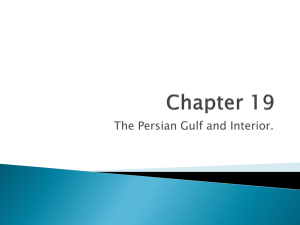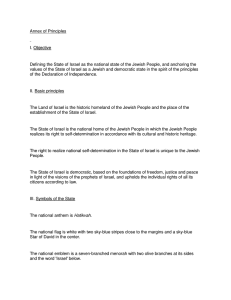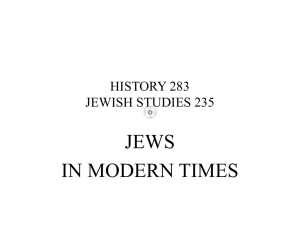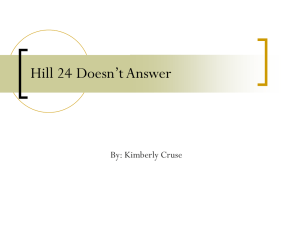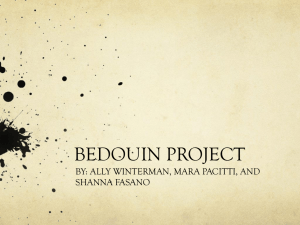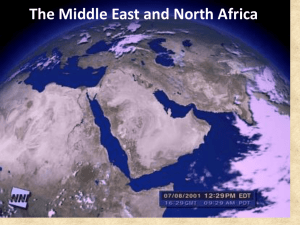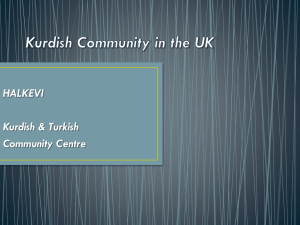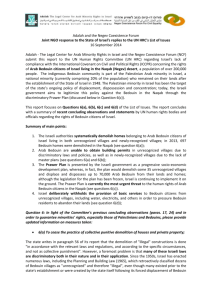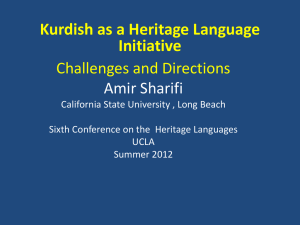Middle East Culture ppt.
advertisement
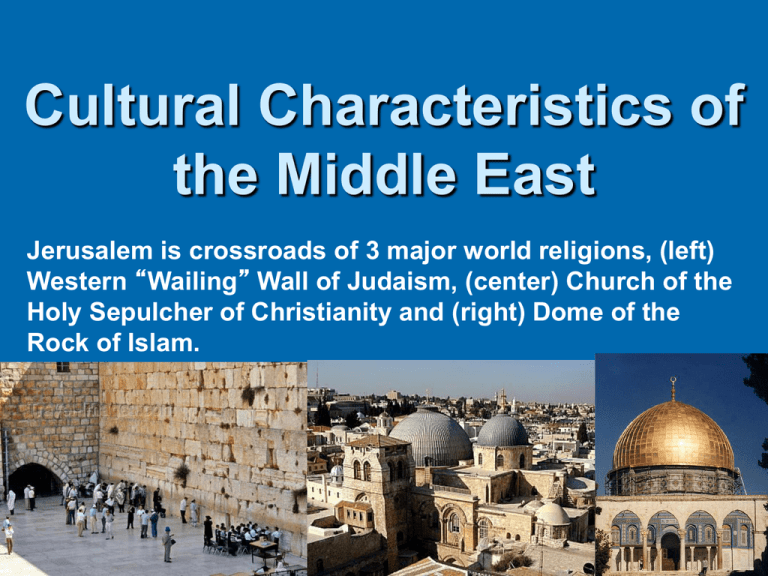
Cultural Characteristics of the Middle East Jerusalem is crossroads of 3 major world religions, (left) Western “Wailing” Wall of Judaism, (center) Church of the Holy Sepulcher of Christianity and (right) Dome of the Rock of Islam. Background Arab peoples make up almost the entire populations of Jordan, Syria, Egypt, Lebanon, and other states of Southwest Asia. Arab culture has a long history and rich traditions. Many other cultures also live in the region. Arab culture has spread across the Middle East and N. Africa. Background Christianity and Judaism are major religions practiced in Southwest Asia. Most people there are Muslims. This means that they practice the religion of Islam. Ninety percent of people in the region are Muslims. Arab Arabs comprise most of the population of Southwest Asia. However, many Arabs also live in Northern Africa, Canada, Europe, and the United States. Most Arabs practice Islam and speak Arabic. Small numbers of Arabs practice other religions. Muslim mosque interior Arab Islam consists mostly of two different groups. Majority practice Sunni Islam (85 %, e.g., Saudi Arabia). Most others practice Shi’ah Islam (15 %, e.g., Iran, Iraq). Sunnis and Shi’ah disagree about who is in charge of the Muslim world – a dispute over who succeeded the Islamic prophet Mohammad at his death (632 A.D.) Holy Kaaba in Mecca, Saudi Arabia, holy city of Islam Shia’ah majorities in Iran and Iraq (brown), Sunni majorities (green). Jewish Israel is home for much of the Jewish population in Southwest Asia. Many of the people who live in Israel today were born there. However, the ancestors of these people moved to Israel from many other countries, often from other Southwest Asian countries. Much of this migration happened during the 20th century, after the formation of Israel in 1948. Jewish Jewish people differ in their religious beliefs, though most practice some form of Judaism. For example, some Jews believe that Jewish people who convert to another religion should not be considered Jewish any more. The “Law of Return” in Israel says that a Jew from any other country can automatically have citizenship in Israel. Sometimes Jews who no longer practice Judaism have been denied the Law of Return. Tel Aviv, Israel’s largest city Jewish Zionism (late 1800s) is the ideology that Israel should be fiendish the homeland for the world’s The Nazi Jews, where they can live free Holocaust 1940s of anti-Semitism and discrimination. Zionism grew from Jews’ return to a homeland (early 20th century before World War II) that would allow them to escape anti-Semitism in Europe. Jewish After the Holocaust (1940s) Zionism was stronger than ever. But, Palestine (before it was Israel) was home to Arabs too. Great Britain (1947), in control of Palestine, tried to partition Arab and Jewish lands, to create separate homeland areas. The plan was accepted by Jews and the new United Nations (72%) but rejected by Palestinian Arabs. Jewish Civil war broke out (1948) between Arabs and Jews. Jews were victorious in the “War of Independence”. Israel is founded May, 1948, later recognized by the required 2/3 majority of the United Nations. Israel from space Controversy of Zionism: Palestine becomes Israel (1948), expands during the Six Day War (1967) and with Jewish West Bank settlements since. Berber Another minority group in the region are the Berbers. Most Berbers live in North Africa and were the first group to settle that region. They still live a traditional way of life today. Berbers have their own languages. Berber woman of North Africa Berber Many Berber tribes live in the mountains and deserts. Most Berbers living in mountainous areas are farmers. Berbers who live in the desert tend to live near an oasis. Berbers that do not farm are nomadic. Berber The majority of Berber tribes are Muslim. Some Berbers practice other religions, too. Traditional Berber cuisine has stayed the same for hundreds of years. Moroccan Berber carpet Bedouin Bedouins are another ethnic group. They speak Arabic. Many Bedouin used to be nomadic. Their most important animal is the camel. Now, the Bedouin live mostly in Saudi Arabia, Syria, Jordan, and Iraq. Bedouin Most Bedouins now live in cities and are not nomadic. Bedouin tribes are ruled by tribal leaders called sheikhs. Most Bedouins practice Islam. The Bedouin are well known for their dress and music, which is mostly sung. Music is used to perform traditional Bedouin ceremonies. Traditional Bedouin wedding procession Persian The Persians are an ethnic group that lived in Iran before the arrival of Islam in the 7th century. Persians make up about half of Iran’s current population. They have their own language called Persian or Farsi. Most Persians in Iran today practice Shi’a Islam, but some are Sunni and other religions. Persian Persian women have faced many challenges as a result of strict cultural and religious practices. Through struggle, Persian women have increased their personal freedoms over the past forty years. Persian art and architecture is also well known. Many people consider Persian rugs to be among the finest in the world. Ancient Persian sculpture and Persian rugs. Kurdish Southwest Asia is also home to the Kurdish people. The Kurds live in several countries throughout the region. These include Turkey, Syria, Iraq, and Iran. Almost one-fifth of the population of Turkey is Kurdish. Kurdish religion used to be made up of a mixture of several different religions, but most are Sunni Muslim. Map of Kurdistan, flag and Turkish Kurd protesters before Turkish invasion of N. Iraq Kurdish Most Kurds today are Muslims. Kurdish Muslims are usually less strict about certain Islamic practices. There are fewer laws for how Kurdish women should dress than there are for Iranian and Arab women. Kurds share many aspects of their culture with Iranians, a country where several live. Turkish The Turks are an ethnic group based on language - Turkish. They live mostly in Turkey and Iran. Most of the people who live in Turkey are of Turkish descent. Most Turks practice some form of Islam. Like Kurds, Turkish people are rarely strict about some Islamic practices. Turkey is located at the crossroads of Europe and Asia Turkish However, Kurds and Turks in Turkey often fight over issues not related to religion. For example, education is a controversial issue between these two groups. Today, the most pressing issue is Kurdish nationalism in Turkey. The Turkish people are well known for their architecture. Mosques in Turkey are a good example of Turkish architecture. Literacy and Development Education is free in many countries in Southwest Asia. Many students are required to attend school through high school. Many students also live so far from the schools that getting to school is difficult. The literacy rates for people over 15 years of age are… Literacy Rates Afghanistan = 28% (m 43%, f 13%) Egypt = 71.4% (m 83%, f 59%) Iran = 77% (m 84%, f 70 %) Iraq = 74% (m 84%, f 64%) Kuwait = 93% (m 94%, f 91%) Saudi Arabia = 78% (m 85%, f 71%) Yemen = 50% (m 71%, f 30%) Pakistan = 50% (m 63%, f 36%) Israel = 97% (m 99%, f 96%) U.S.A. = 99% (m 99%, f 99%) Norway = 100% (m 100%, f 100%) Source: CIA World Fact Book, 2010 Literacy and Development The literacy rates in Israel are higher than in other Southwest Asian countries. In all of these countries, more men tend to be able to read and write than women. This is especially true in Syria, Iran, and Saudi Arabia. Overall, in some countries women’s education is not valued as much as men’s education. Literacy and Development Women receive a different education than men in some areas. Literacy has a large impact on a country’s development. For example, an increase in the literacy rate often leads to an increase in individual rights, societal self-determination (democracy). Literacy rates also have an impact on a country’s economy. Iranian woman, where education for women is common, protests a 2009 election



